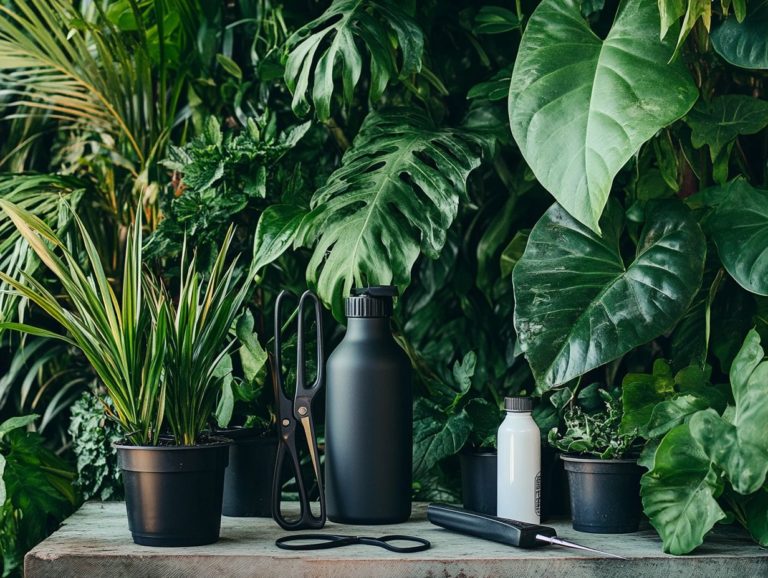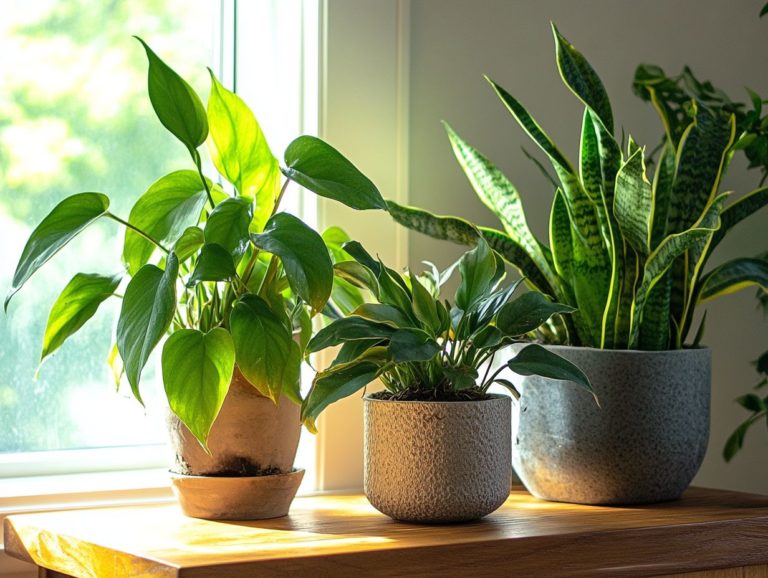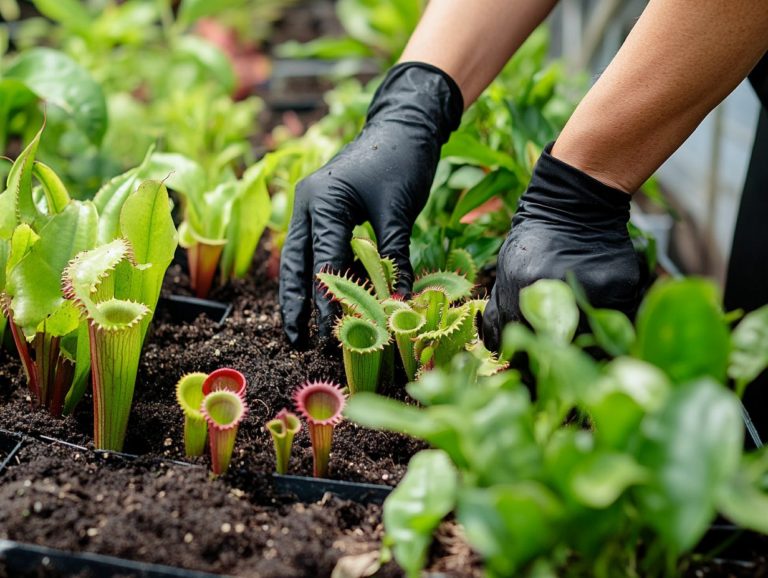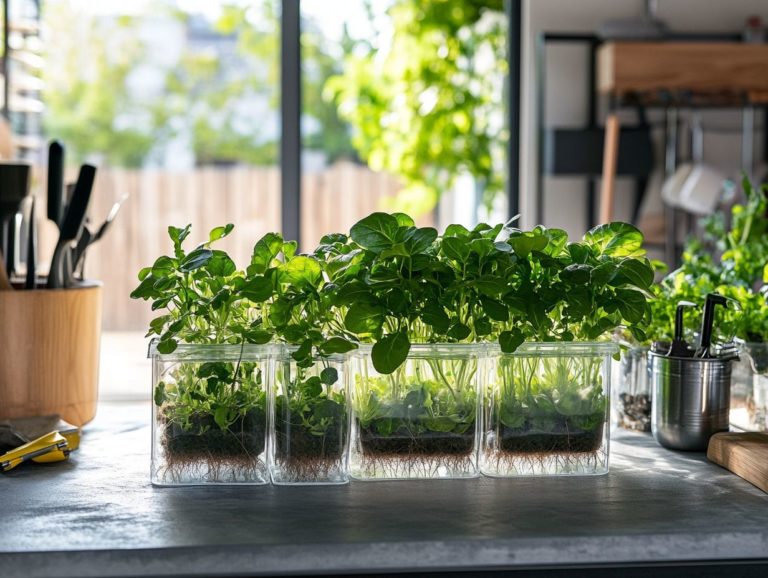8 Common Indoor Plants and Their Propagation Methods
Indoor plants can effortlessly infuse your home with a refreshing touch of nature, offering not just aesthetic appeal but also a host of health benefits. They act as beautiful additions that provide visual excitement.
Get ready to explore eight amazing indoor plants that will brighten your space! This article features the adaptable Spider Plant and the hardy ZZ Plant, while providing insights on effective propagation techniques and various methods for success. Whether you re a seasoned plant parent or just beginning your green journey, you ll discover valuable tips for caring for newly propagated plants, troubleshooting common challenges, and ensuring successful growth.
Don t wait! Elevate your space with stunning greenery today!
Contents
- Key Takeaways:
- 1. The Amazing Spider Plant: Your New Best Friend
- 2. Meet the Snake Plant: The Ultimate Low-Maintenance Companion
- 3. Pothos: A Beautiful Choice for Your Indoor Garden
- 4. Philodendron
- 5. ZZ Plant
- 6. Chinese Evergreen
- 7. Peace Lily
- 8. Aloe Vera
- What Are the Benefits of Having Indoor Plants?
- Air Quality
- Mental Health
- Popular Plants
- What Are the Different Ways to Propagate Indoor Plants?
- How Long Does It Take for Indoor Plants to Grow from Propagation?
- What Are the Best Conditions for Propagating Indoor Plants?
- What Are the Most Common Mistakes When Propagating Indoor Plants?
- How Can One Care for Newly Propagated Indoor Plants?
- What Are the Signs of a Successful Propagation?
- How Can One Troubleshoot Unsuccessful Propagations?
- Frequently Asked Questions
- What are the 8 common indoor plants that can be propagated?
- What is the best method for propagating Snake Plants?
- Can Spider Plants be propagated in water?
- What is the recommended way to propagate Jade Plants?
- How can Pothos be propagated from a mature plant?
- Is it possible to propagate Aloe Vera from a single leaf using leaf propagation techniques?
- What is the best way to propagate Peace Lilies, and how can plant division be optimized?
- Can Philodendron be propagated from stem cuttings, and what are the best watering tips?
Key Takeaways:

- Propagating indoor plants is an affordable and rewarding way to expand your plant collection.
- Common indoor plants like spider plants, snake plants, and pothos can be easily propagated through stem cuttings or division.
- Successful propagation requires proper care, patience, and troubleshooting for any potential mistakes.
1. The Amazing Spider Plant: Your New Best Friend
The Spider Plant (Chlorophytum comosum) stands out as one of the most beloved indoor plants, celebrated for its remarkable air-purifying capabilities and ease of care. It s the perfect choice for both novice and seasoned indoor gardeners.
With its vibrant green leaves and adaptability to various conditions, it brings a dash of visual delight to any space. You can easily expand your collection by propagating this plant through stem cuttings.
This resilient beauty thrives in bright, indirect sunlight but is also adaptable enough to flourish in lower light conditions, making it a versatile addition to any indoor environment. To keep it happy, ensure you use a well-draining potting mix; a blend of potting soil and perlite provides excellent aeration.
Water it moderately, allowing the top inch of soil to dry out before giving it another sip, as overwatering can lead to the dreaded root rot.
In terms of propagation, simply trim off those charming spiderettes and pop them in water or directly into soil. You’ll soon see quick results, making it easy to share your love for this delightful species with friends and family.
2. Meet the Snake Plant: The Ultimate Low-Maintenance Companion
The Snake Plant (Sansevieria trifasciata), famously dubbed Mother-in-Law’s Tongue, is the ultimate indoor companion for anyone who prefers a plant that thrives on a little neglect. If you’re in the market for a low-maintenance houseplant that still elevates your home decor, look no further.
This remarkable plant can survive without much water, flourishing even in less-than-ideal conditions. To ensure its success, consider placing it in well-draining soil to prevent that pesky root rot that plagues so many indoor plants.
For optimal growth, maintain the right moisture levels with thoughtful watering; allowing the soil to dry out completely between waterings mimics its natural habitat beautifully.
With its striking upright leaves, the Snake Plant not only purifies the air but also adds a touch of artistry to your living spaces. It s no wonder this plant has earned a special place in the hearts of plant enthusiasts.
3. Pothos: A Beautiful Choice for Your Indoor Garden
Pothos (Epipremnum aureum) is a versatile and beloved indoor plant, celebrated for its stunning trailing vines and heart-shaped leaves. It s an exceptional choice for infusing your indoor space with vibrant greenery and aesthetic appeal.
If you’re considering propagating this delightful plant, leaf cuttings provide an accessible and rewarding method. When you take cuttings, ensure that each segment includes at least one node, as this is the crucial point where new roots will emerge.
To enhance root development, think about using a growth hormone; it can significantly increase your chances of successful propagation. Once you’ve prepared the cuttings, place them in a warm, bright location, but keep them out of direct sunlight to create the ideal environment.
Regularly check moisture levels and provide indirect light to help the new growth flourish, transforming your cuttings into thriving plants that elevate the beauty of any living space.
4. Philodendron
Philodendrons are a captivating collection of indoor plants, known for their exquisite foliage and remarkable adaptability. It is no wonder they have become a favorite among indoor gardening enthusiasts who admire their graceful beauty and effortless ways to grow new plants.
With an array of varieties, including the elegant Heartleaf, the iconic Split-Leaf, and the eye-catching Pink Princess, you have many shapes, colors, and sizes to enhance any interior space.
Proper care is essential; these plants thrive in high humidity, ideally between 60-80%. You can easily achieve this through misting or by using a humidity tray.
For growing new plants, using stem cuttings is a favored method. Ensure that your cuttings receive sufficient moisture and indirect light to support robust development.
With a bit of care today, you can enjoy beautiful plants tomorrow! You will be amazed at how quickly they grow into stunning specimens that elevate your indoor landscape.
5. ZZ Plant
The ZZ Plant (Zamioculcas zamiifolia) is a stylish choice for your indoor space, featuring glossy, dark green leaves that exude elegance. Its exceptional resilience means it thrives even in low-light conditions and requires minimal maintenance ideal for those with busy lifestyles.
This plant also has interesting ways to grow new plants. You can propagate the ZZ Plant through leaf nodes, where small sections of a leaf or even a single leaf can develop into a brand-new plant over time.
To help your cuttings flourish, place them in well-draining soil and provide indirect sunlight. Be mindful of your watering habits too much moisture can lead to rot.
With a sprinkle of patience and the right care tips, like maintaining adequate humidity levels and avoiding overcrowding, you can cultivate a thriving ZZ Plant that will grace your space for many years to come.
6. Chinese Evergreen

Chinese Evergreen (Aglaonema) is the indoor plant you ve been searching for, known for its stunning patterns and vibrant colors that effortlessly elevate any home or office space, all while being wonderfully low-maintenance.
To ensure your plant flourishes, it s vital to keep the soil consistently moist, but be cautious overwatering can lead to root rot. Your Chinese Evergreen thrives in indirect light, which helps maintain its brilliant foliage.
If you re interested in growing new plants, consider the method of division. This allows you to gently separate the plant into sections during repotting, creating new plants and promoting healthier growth by easing crowding in the pot.
7. Peace Lily
The Peace Lily (Spathiphyllum) is a captivating flowering plant that not only enhances the beauty of your indoor space but also purifies the air, making it a favorite among plant enthusiasts for its aesthetic appeal and health benefits.
To keep this beauty thriving, consistent care is essential. Ensure the soil remains adequately moist without becoming oversaturated. Watering it about once a week should do the trick, allowing the top inch of soil to dry out between waterings an essential tip for optimal plant health.
Peace Lilies thrive in indirect light direct sunlight can scorch their delicate leaves, yet they will still bloom beautifully even in lower light conditions.
If you re interested in growing new plants, you can easily divide the plant during repotting. Just be sure to keep those roots intact.
With the right attention, you can encourage continued flowering throughout the year, creating a delightful display that brightens your home.
8. Aloe Vera
Aloe Vera (Aloe barbadensis miller) is not just any succulent; it s a stunning blend of beauty and utility that deserves a prime spot among your indoor plants. Its medicinal properties and decorative charm make it a true essential for anyone looking to enhance their living space while benefiting from its home remedy capabilities.
To ensure this resilient plant thrives, follow a few key care guidelines. Understanding watering frequency and soil mixture is crucial. First and foremost, provide it with well-draining soil to prevent water from pooling, which can lead to dreaded root rot.
Watering involves a careful balance. Allow the soil to dry out between waterings to ensure your plant gets just the right amount of moisture without drowning in excess water.
If you re keen on propagation, using cuttings is a highly effective approach. By carefully selecting healthy stems and utilizing the right gardening supplies like quality potting mix and rooting hormone you can encourage successful root growth. This rewarding endeavor allows you to nurture new plants while expanding your green sanctuary.
What Are the Benefits of Having Indoor Plants?
Having indoor plants in your home offers a multitude of benefits. They transform your environment in ways that go beyond mere aesthetics.
Air Quality
Not only do they enhance air quality through natural purification processes, but they also filter out toxins like formaldehyde and benzene, contributing to a healthier living space.
Mental Health
Indoor plants provide a significant boost to your mental health by reducing stress and creating a calming atmosphere. Interacting with greenery has been proven to lower cortisol levels, effectively reducing anxiety.
Popular Plants
Take the resilient spider plant, for instance. It’s celebrated for its ability to absorb pollutants while requiring minimal maintenance perfect for your busy lifestyle. Peace lilies not only bloom beautifully but also eliminate harmful chemicals and increase humidity, helping to alleviate dry skin and respiratory issues.
By incorporating these plants into your home, you foster a sense of tranquility that enhances your overall well-being. Start your indoor garden today!
What Are the Different Ways to Propagate Indoor Plants?
There are several effective propagation methods for indoor plants, each suited to different species. You can utilize stem cuttings, leaf propagation, or even separate root sections to encourage the growth of new plants.
Understanding which method works best for each plant can enhance your success in cultivating new specimens dramatically.
For instance:
- Stem cuttings work wonders for vining plants like pothos and philodendron.
- Leaf propagation excels with succulent species.
- For plants like spider plants or certain types of orchids, separating root sections is the way to go.
To ensure a seamless propagation experience, prepare your cuttings properly. Always use clean, sharp tools to prevent infection, and pay attention to timing; some plants thrive better during specific seasons. Providing the right humidity and light also plays a key role in nurturing that new growth you re aiming for.
How Long Does It Take for Indoor Plants to Grow from Propagation?
The time it takes for indoor plants to grow from propagation can vary significantly. Factors include the species, method used, and environmental conditions.
You might notice some cuttings showing impressive growth within just a few weeks, while others could take several months to develop substantial roots.
Humidity levels, light exposure, and temperature are crucial factors. For example, pothos and spider plants often flourish in typical household settings, revealing signs of growth in just two to four weeks. On the other hand, species like philodendrons may demand a bit more patience.
The propagation method itself whether you’re using water, soil, or even air layering can greatly influence both the success and speed of root formation. By understanding these nuances, you can tailor your care practices to meet the specific needs of your green companions, ensuring they thrive under your attentive care.
Share your plant care experiences below and join the community of indoor gardening enthusiasts!
What Are the Best Conditions for Propagating Indoor Plants?
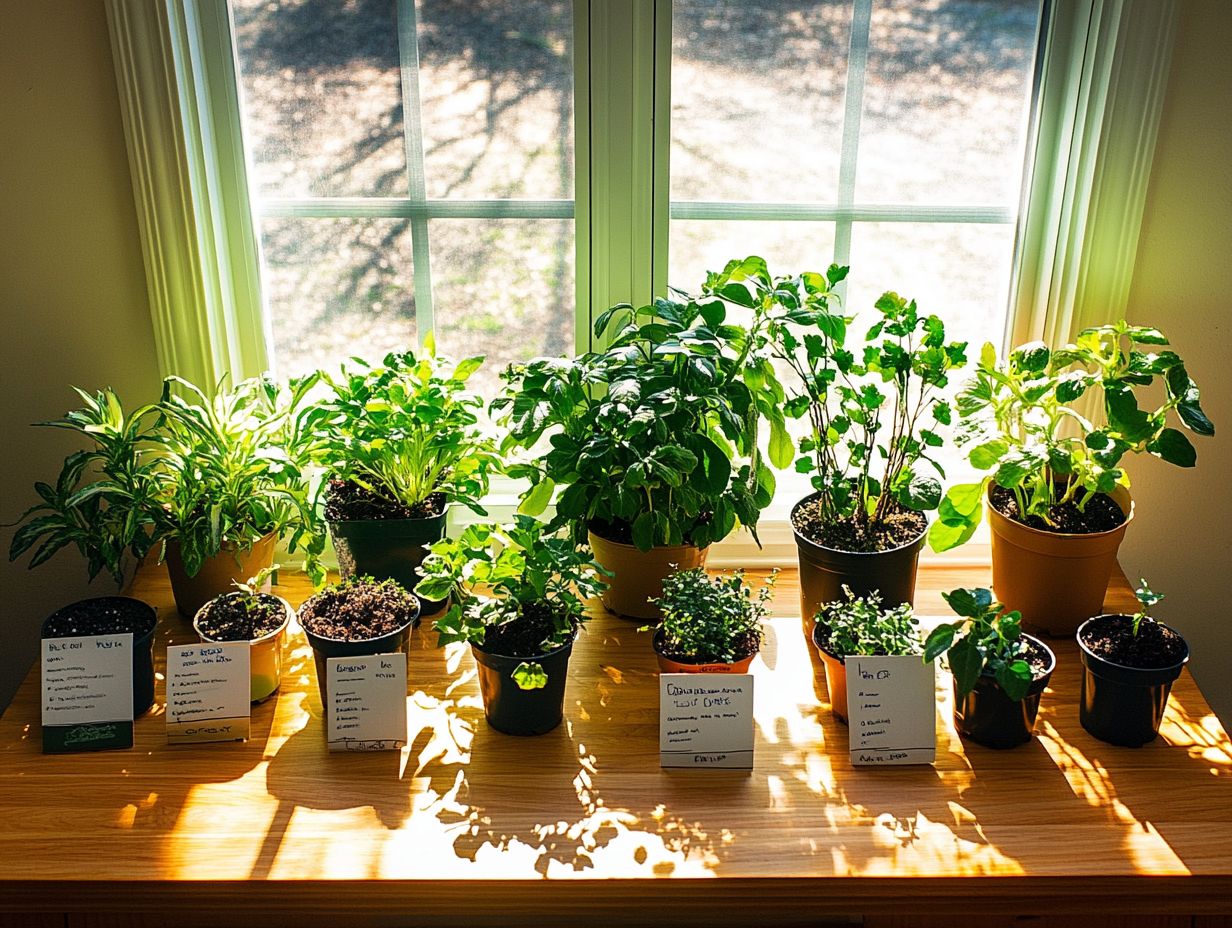
To successfully propagate your indoor plants, you need to create specific conditions. This means maintaining high humidity and ensuring the soil remains moist. You might also consider using natural substances that help plants grow stronger to encourage strong root development.
The right amount of light is crucial. Providing bright, indirect sunlight will stimulate leaf growth while avoiding harsh direct rays that can scorch delicate cuttings.
Temperature matters too. Most indoor plants thrive in a cozy range of 65 F to 75 F. This not only supports growth but keeps your cuttings healthy and vibrant.
Aim for humidity levels around 70-80% for your young cuttings. You can achieve this by misting them or placing a humidity dome over the plant.
For established plants, regular watering and fertilization during the growing season will boost their health. This prevents stress and ensures they flourish beautifully as they mature.
What Are the Most Common Mistakes When Propagating Indoor Plants?
Many indoor gardeners stumble over common mistakes when propagating plants, such as overwatering, using poor-quality soil, or neglecting the care of their cuttings. These missteps can lead to lackluster growth or even plant diseases.
Avoid these common mistakes to keep your indoor garden thriving! You might underestimate the importance of selecting the right potting mix, which should balance adequate drainage and moisture retention.
Understanding the specific light and humidity requirements of different plant varieties can significantly impact your propagation success. By paying attention to these details, you can boost the survival rate of your cuttings and promote robust growth, ultimately crafting a more vibrant indoor ecosystem.
How Can One Care for Newly Propagated Indoor Plants?
Caring for your newly propagated indoor plants demands finesse, focusing on proper watering techniques, the right soil mixture, and vigilant monitoring of environmental factors to foster robust growth.
Striking the ideal balance in watering is crucial. Too much moisture risks root rot, while too little can stunt their growth. Water your plants when the top inch of soil feels dry to the touch, allowing for a thorough soak that drains effectively.
Opting for a well-draining potting mix supports healthy roots. Light exposure plays a vital role too; most young plants excel in bright, indirect sunlight, but some might need specific adjustments based on their unique species.
Don t overlook humidity levels. Many propagated plants thrive in slightly more humid settings, which you can achieve through regular misting or by placing a humidity tray nearby.
Act quickly! Pests and fungal infections can threaten your plants if not addressed promptly. By keeping a close watch on your plants and maintaining a clean environment, you can prevent these issues and ensure they flourish in their new homes.
What Are the Signs of a Successful Propagation?
Identifying the signs of successful propagation in your indoor plants is essential. Look for indicators such as healthy root development, new leaf nodes, and an overall sense of vigor these are all clear signals that your propagation efforts have paid off.
In addition to these key signs, observing a robust structure can further assure you of thriving growth. For example, succulent species like jade plants often showcase plump leaves, indicating they re getting enough water.
Fast-growing plants like pothos display vigorous vine elongation, a sure sign of their vitality. The appearance of fresh, green foliage is another positive sign; this is especially true for herbs like basil, which flourish with consistent light and moisture.
Pay attention to subtle cues, such as a change in color or a sudden burst of new growth these can reveal your plant’s health and readiness for repotting, reinforcing the success of your propagation journey.
By following these tips, you can enjoy a thriving indoor garden that brings joy and beauty to your home.
How Can One Troubleshoot Unsuccessful Propagations?
Troubleshooting unsuccessful propagations of your indoor plants requires careful analysis. Look into factors like environmental conditions, soil mixture, and plant diseases that could stunt growth.
Start by assessing whether your plants receive adequate light. Insufficient exposure leads to weak growth.
Next, evaluate your watering routine. Both over-watering and under-watering can sabotage healthy root development.
Check for pests, which can harm plant health. They often lurk unnoticed but can wreak havoc.
Using well-draining, nutrient-rich soil boosts your chances of success. By addressing these elements, you can refine your propagation techniques.
Frequently Asked Questions
What are the 8 common indoor plants that can be propagated?
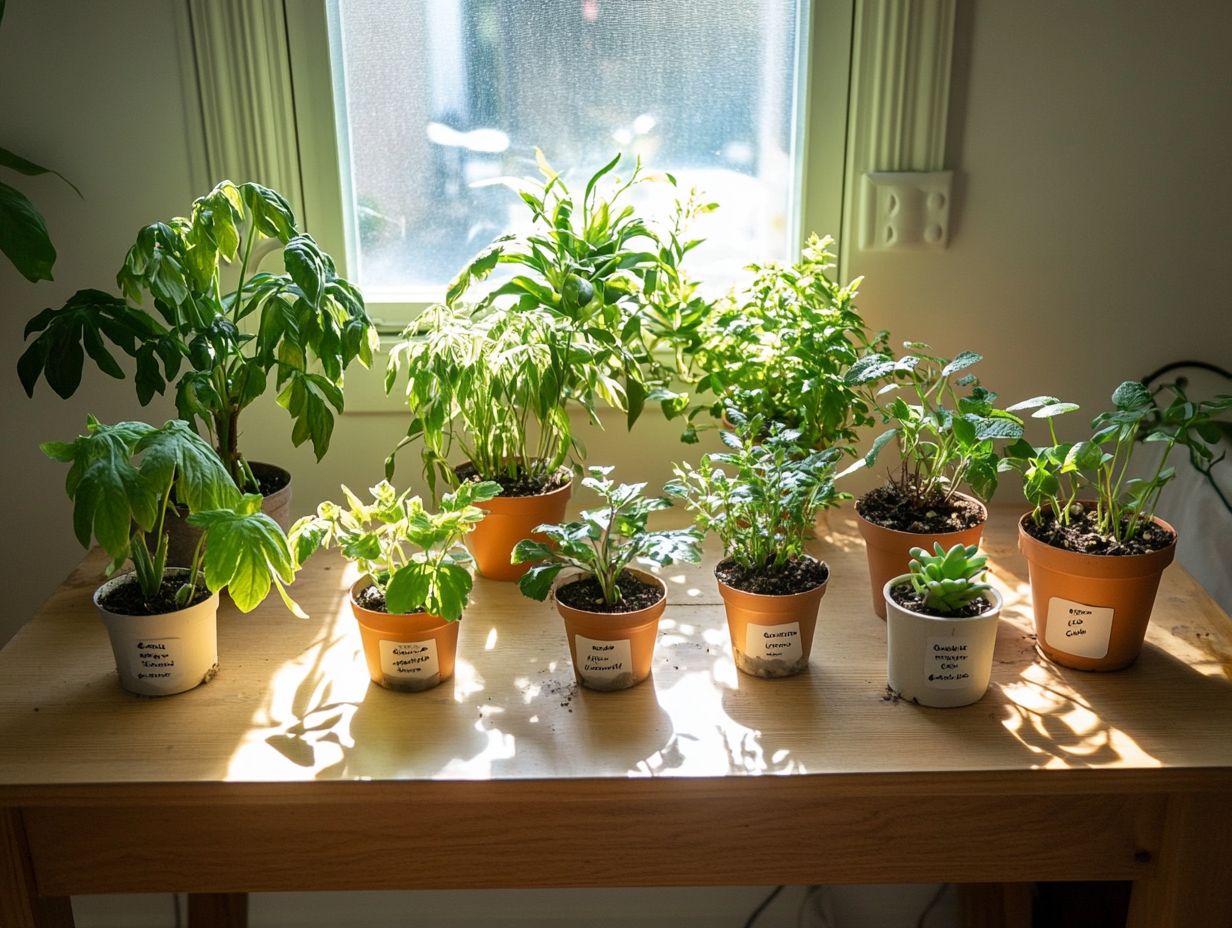
The common indoor plants that can be propagated include:
- Snake Plant
- Spider Plant
- Jade Plant
- Pothos
- Aloe Vera
- Peace Lily
- Philodendron
- Rubber Plant
What is the best method for propagating Snake Plants?
The best method is division, where the plant is split into smaller plants with their own roots.
Can Spider Plants be propagated in water?
Yes! You can easily propagate your Spider Plants in water by placing the plantlet in a jar until roots form.
What is the recommended way to propagate Jade Plants?
Jade Plants can be propagated by stem or leaf cuttings. Simply plant the cuttings in well-draining soil and place them in a warm, bright location.
How can Pothos be propagated from a mature plant?
Pothos can be propagated through stem cuttings from a mature plant. Ensure the cutting has at least 2-3 nodes (the small bumps on the stem where leaves grow) and place it in water or soil until roots develop.
Is it possible to propagate Aloe Vera from a single leaf using leaf propagation techniques?
Yes, Aloe Vera can be propagated from a single leaf. Let the cut end dry for a day before planting it in well-draining soil.
What is the best way to propagate Peace Lilies, and how can plant division be optimized?
Peace Lilies can be propagated by division during repotting. Split the plant into smaller sections, each with its own roots.
Can Philodendron be propagated from stem cuttings, and what are the best watering tips?
Yes! Propagate Philodendron from stem cuttings, ensuring the cutting has at least one node. Place it in water or soil until roots develop.


